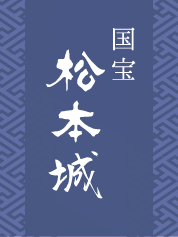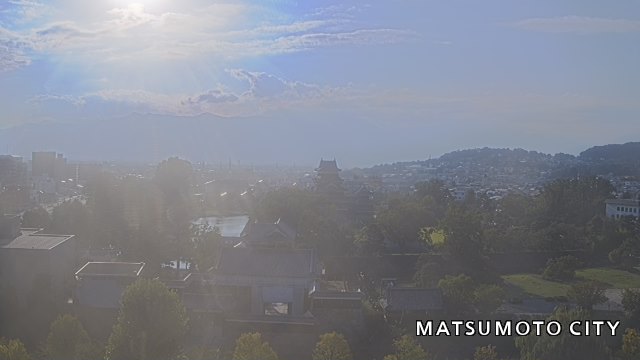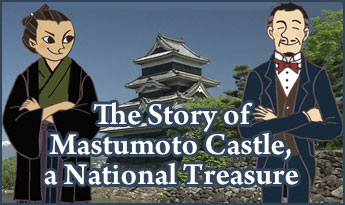North trail
From Taiko gate to Ninomaru Palace you can enjoy the samurai houses.
You can enjoy the house of Takahashi family which is a samurai residence, a house of the first mayor of a Matsumoto city, Yorinaga Ori and the house where Yasumasa Fukushima, a former general in the Imperial Japanese Army.
Route map
- Taikomon (Taiko Gate)
- A trace of Ninomaru castle
- Kita-akazunomon and Matsumoto Shrine
- Kita-baba and the well of Yanagi
- A large well
- A trace of the house of the first mayor Yorinaga Ori
- A trace of the house where a general Yasumasa Fukushima was born.
- House of the Takahashi family
- Daimonzawa River
- A trace of the Kenchuji
There are many segments to the north trail

Taikomon (Taiko Gate)
Magnificent and very well constructed gate leading to the main enclosure of a castle and outer citadel.
Taikomon was a very important gate to the main enclosure of a castle and outer citadel. It is magnificent and very well constructed.
There was a turret next to the Taikomon (Taiko gate) and the drum and bell were positioned. This drum and bell were used to inform the local inhabitants the time and when the samurai was on the way to the castle. Therefore this gate is called Taikomon (Taiko Gate)
However when the samurai period ended, this gate was slammed in 1871.
Because the gate was very significant to the local people they had desired to have it reconstructed. And this wish was fulfilled in 1998.
On the east side of the gate, there is the biggest stone in Matsumoto castle. This stone is called “Genba Ishi” (Genba Stone) after the office of Yasunaga Ishikawa who constructed the castle tower.- Continue to walk about 1 minute

A trace of Ninomaru castle
It was a center of the politics for domains until the Meiji restoration.
There were three castles in Matsumoto castle at the beginning including Honmaru Castle, Ninomaru Castle and Kosanji Castle.Castle was used as a residence of Lord and his family, a place to visit with his guests and a place to do the domain politics.
On the first New Year after Mr. Toda came to Matsumoto, Honmaru castle was burnt down. They moved their lifestyle and politics to Ninomaru Goten. From then this was the center of politics for Matsumoto domain until the Meiji Restoration.
During the Meiji era, when Chikuma was located instead of Matsumoto domain the castle became a prefectural office. In 1876 the building was burnt down. The court was built in the same location.
When the court was relocated to the location now, this old court was kept as a judicial museum and the area was excavated. Rooms, kitchen and well were excavated as well as equipments, shellfish and fish bones.
There is an information board in where the castle was so people can learn about the former building.- Continue to walk about 2 minutes

Kita-akazunomon and Matsumoto Shrine
The gate which does not open usually and the shrine which worships the ancestors of Mr. Toda.
There was a gate in the Northwest of the castle. Because it was located in the north and was closed most of the times, it was called "akazunomon" ( a gate which never opens). There was also the West Gate which was closed most of the times and was called Nishi-Akazunomon.
In from of the gate, there was a protection of the castle. Because the gate is no longer here, there is a monument to direct the location of the gate.
When the Lord of Toda came to Matsumoto, he built the shrine here. It was first called "youkoku reisha". Eventually there were five ancestors of the Lord Toda were worshipped, it was named "Gosha" (five shrines).
The building on the right hand side is the Gosha. Wakamiya Hachiman which has a deep relationship with Matsumoto castle was relocated on the left side of the Gosha, therefore two buildings have been called Matsumoto Shrine since 1953.
Shrine parishioners take care and protect a large keyaki tree. In the southwest of the precinct ground, there is a new well. The water is enjoyed by both people from Matsumoto and tourists.- Continue to walk about 4 minutes

Kita-baba and the well of Yanagi
One of the riding grounds of the three near the castle and a new well.
In the north of Matsumoto Shrine there was a moat. In the north of the most was a east-west road and was used as a riding ground. This is the place where horses are trained. There were three riding grounds, Yanagi (East of the city office), Aoi (South of Matsumoto shrine) and Kita.
The moat is now buried but if you look carefully, from Matsumoto shrine to the east, you can see a division such as court, parking, and etc. A trace of the moat. Before it was relocated to the ward of Imai in Matsumoto, there was a public pool here.
Since there was a moat, there was a water gush out in a moat which is now a well. The well of Yanagi is located near the parking for city employees. You may see people who clean around the well. a mount area where a tree is in the south of the parking is a trace of the mount of earth.
In the north of the road the land where a lyric writer of the prefectural song "the country Shinano" Retsu Asai was born.- Continue to walk about 1 minute

A large well
Very rare location to see the well.
This is where the North Gate was located. It is now banished and is no longer here. This gate was used by samurai who lived in the north of the castle when they commuted to the castle.
There was a moat in the north of the gate. The area of the moat still remains as a embankment. There was a protection in the north of the moat so the enemies could not invade easily. The houses were built on the ground of the protection moat but depending on the roads you may be able to see a trace of divisions. This is a rare location where you can see both the protection and moat.
During the Meiji era, a well was built using a spring water. Spring water still can be enjoyed today and neighbors call the well "ooido" (big well).
If you stand on top of the hill and look right and left, you can see the moat curving to the west.- Continue to walk about 3 minutes

A trace of the house of the first mayor Yorinaga Ori
The first mayor who made a foundation of city Matsumoto.
In 1907, a town Matsumoto became a city Matsumoto. The first mayor of Matsumoto city was Yorinaga Ori. Yorinaga Ori's house was here.
Ori was born as a child of samurai family in Matsumoto. His father services in Edo so he was born in Edo. When he returned to Matsumoto he learnt at school of the domain and from Meiji era he learnt at Kaichi School. He became a teacher and a journalist for a newspaper. And he became a member of an assembly and started to show his ability as a politician.
When he was a mayor of a Matsumoto town, the town became a city, therefore he continued to be a mayor of a Matsumoto city. When he became a mayor of a city, he conducted a lot of movements such as attempting to move a prefectural office from Nagano to Matsumoto, founding a army base to Matsumoto, establishing a branch of Bank of Japan, building a Matsumoto High School. This movement was to build a city as strong as Nagano city where the prefectural office is located. Ori continued to serve as a mayor of a Matsumoto city for 30 years until his retirement in 1937.- Continue to walk about 3 minutes

A trace of the house where a general Yasumasa Fukushima was born.
A full general who traversed Siberia by horse.
The top position in the army was a full general. Yasumasa Fukushima became a full general of the army. He is also famous because he traversed Siberia by himself by horse.
Fukushima went to Edo with a Lord to study but when the samurai era ended, there was no support from a Lord and it was hard to continue studying. However Fukushima continued to study despite a poor by borrowing a textbook from friends, wearing only a thin clothes, screaming loudly when it was too cold. When he mastered a foreign language, he joined the army and travelled around the world and shared information about the army in other countries.
He had to go back to Japan from Germany so he travelled all the way from Europe to Russia to Japan by himself. He travelled with a horse and finally arrived in Japan after a difficult days. He travelled about 14,000 km in 488 days. This news surprised everyone in Japan.
Japan had a war with China and Russia and it is said that the information from Fukushima was very useful during the war.- Continue to walk about 2 minutes

House of the Takahashi family
The samurai house from the Edo era
There are not many houses from the Edo era in a city of Matsumoto. The reason of it is because there were a few fire incidents and people had moved and houses were rebuilt.
The house of Takahashi family is an important building which has an aspect of samurai house from the Edo era. The house was taken care of by the family but when it was donated to a city, a repair was done and neighbors are now taking care of a house.
During the Edo era, everything such as a house and job were decided so people could not do what they wanted. The house was given by a Lord. The family of Takahashi lived here and the householder worked at a domain office.
You can see the living of Takahashi Family from the fence in front of the house, stones which is holding a roof, layout of a house, pillars and ceilings, 4 rooms, kitchen, and a well in the garden.
1. Days Open
(1)March - November: weekends and national horidays
(2)December - February: Sunday
(Closed: Dec.29th - Jan.3rd)
2. Hours of Operation: 9am - 5pm (Last entry at 4:30pm)- Continue to walk about 1 minute

Daimonzawa River
The important river which divide town and fields.
Daimonzawa River becomes one river at the Central library from three rivers, Nishi-daimonzawa river from the west of the Alps, Daimonzawa river from Morokubo and Higashimachi-Daimonzawa river from Hongo.
The northwest of the castle environs was divided by Daimonzawa River. East side was a castle environs and the west side was a village with fields. Daimonzawa River curves a lot and at some points it curves in right angles. Both sides of the river are covered with stones or concrete but the trail of the river has not changed from many years ago. When there is too much water it sometimes caused people a problem.
On the right side of the picture the street of Okachimachi can be seen. On the left side of the picture is Sawamura. On the side of Okachimachi there was a fence to avoid suspicious people coming into the castle environs. There was a Kenchu Temple on the left hand side.- Continue to walk about 1 minute

A trace of the Kenchuji
A guardian deity of children which is known to heal sick children.
A temple was located near the Daimonzawa River. This temple was built by the Lord of Mizuno when he came to Matsumoto. "Kenchu" is from his ancestor Tadashige Mizuno and he was worshipped in this temple.
Also the ancestors of his wife were worshipped here. The temple continued even after he left but during the Meiji era the temple was no longer serviced.
In where the temple was, there is a guardian deity of children. This guardian deity of children was made of stone. Its neck and body are separated. One day a theft came to the house and stole stuff from one of the neighbors. When people went there, there was a crying baby. When people saw a baby they were happy to see somebody alive. They realized that there was a head of the guardian deity of children next to a baby. this baby is alive because the guardian deity of children saved a baby instead of his life. Since then it is said that whenever children get sick, people would take the head to the house and heal the sickness of children.
In the west of the Kenchu temple, the building called Sanzouin was located. There are very old statues in the building. They were located at the boarder of the village to stop suspicious people from coming in.


















